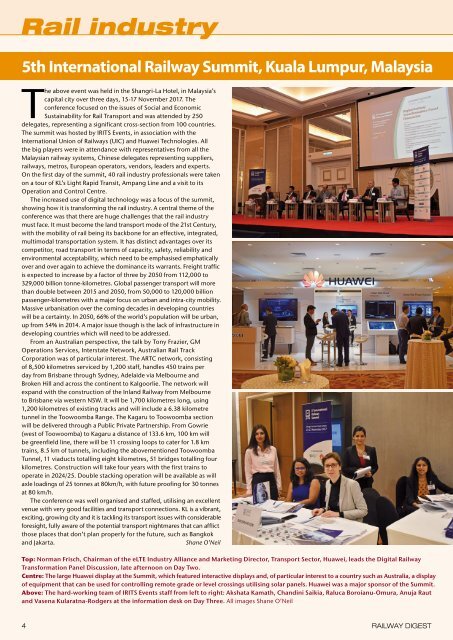Railway_Digest__February_2018
You also want an ePaper? Increase the reach of your titles
YUMPU automatically turns print PDFs into web optimized ePapers that Google loves.
Rail industry<br />
5th International <strong>Railway</strong> Summit, Kuala Lumpur, Malaysia<br />
The above event was held in the Shangri-La Hotel, in Malaysia’s<br />
capital city over three days, 15-17 November 2017. The<br />
conference focused on the issues of Social and Economic<br />
Sustainability for Rail Transport and was attended by 250<br />
delegates, representing a significant cross-section from 100 countries.<br />
The summit was hosted by IRITS Events, in association with the<br />
International Union of <strong>Railway</strong>s (UIC) and Huawei Technologies. All<br />
the big players were in attendance with representatives from all the<br />
Malaysian railway systems, Chinese delegates representing suppliers,<br />
railways, metros, European operators, vendors, leaders and experts.<br />
On the first day of the summit, 40 rail industry professionals were taken<br />
on a tour of KL’s Light Rapid Transit, Ampang Line and a visit to its<br />
Operation and Control Centre.<br />
The increased use of digital technology was a focus of the summit,<br />
showing how it is transforming the rail industry. A central theme of the<br />
conference was that there are huge challenges that the rail industry<br />
must face. It must become the land transport mode of the 21st Century,<br />
with the mobility of rail being its backbone for an effective, integrated,<br />
multimodal transportation system. It has distinct advantages over its<br />
competitor, road transport in terms of capacity, safety, reliability and<br />
environmental acceptability, which need to be emphasised emphatically<br />
over and over again to achieve the dominance its warrants. Freight traffic<br />
is expected to increase by a factor of three by 2050 from 112,000 to<br />
329,000 billion tonne-kilometres. Global passenger transport will more<br />
than double between 2015 and 2050, from 50,000 to 120,000 billion<br />
passenger-kilometres with a major focus on urban and intra-city mobility.<br />
Massive urbanisation over the coming decades in developing countries<br />
will be a certainty. In 2050, 66% of the world’s population will be urban,<br />
up from 54% in 2014. A major issue though is the lack of infrastructure in<br />
developing countries which will need to be addressed.<br />
From an Australian perspective, the talk by Tony Frazier, GM<br />
Operations Services, Interstate Network, Australian Rail Track<br />
Corporation was of particular interest. The ARTC network, consisting<br />
of 8,500 kilometres serviced by 1,200 staff, handles 450 trains per<br />
day from Brisbane through Sydney, Adelaide via Melbourne and<br />
Broken Hill and across the continent to Kalgoorlie. The network will<br />
expand with the construction of the Inland <strong>Railway</strong> from Melbourne<br />
to Brisbane via western NSW. It will be 1,700 kilometres long, using<br />
1,200 kilometres of existing tracks and will include a 6.38 kilometre<br />
tunnel in the Toowoomba Range. The Kagaru to Toowoomba section<br />
will be delivered through a Public Private Partnership. From Gowrie<br />
(west of Toowoomba) to Kagaru a distance of 133.6 km, 100 km will<br />
be greenfield line, there will be 11 crossing loops to cater for 1.8 km<br />
trains, 8.5 km of tunnels, including the abovementioned Toowoomba<br />
Tunnel, 11 viaducts totalling eight kilometres, 51 bridges totalling four<br />
kilometres. Construction will take four years with the first trains to<br />
operate in 2024/25. Double stacking operation will be available as will<br />
axle loadings of 25 tonnes at 80km/h, with future proofing for 30 tonnes<br />
at 80 km/h.<br />
The conference was well organised and staffed, utilising an excellent<br />
venue with very good facilities and transport connections. KL is a vibrant,<br />
exciting, growing city and it is tackling its transport issues with considerable<br />
foresight, fully aware of the potential transport nightmares that can afflict<br />
those places that don’t plan properly for the future, such as Bangkok<br />
and Jakarta.<br />
Shane O’Neil<br />
Top: Norman Frisch, Chairman of the eLTE Industry Alliance and Marketing Director, Transport Sector, Huawei, leads the Digital <strong>Railway</strong><br />
Transformation Panel Discussion, late afternoon on Day Two.<br />
Centre: The large Huawei display at the Summit, which featured interactive displays and, of particular interest to a country such as Australia, a display<br />
of equipment that can be used for controlling remote grade or level crossings utilising solar panels. Huawei was a major sponsor of the Summit.<br />
Above: The hard-working team of IRITS Events staff from left to right: Akshata Kamath, Chandini Saikia, Raluca Boroianu-Omura, Anuja Raut<br />
and Vasena Kularatna-Rodgers at the information desk on Day Three. All images Shane O’Neil<br />
4<br />
RAILWAY DIGEST


